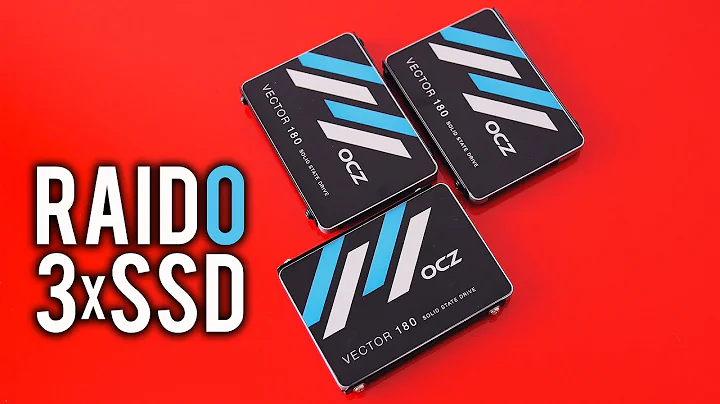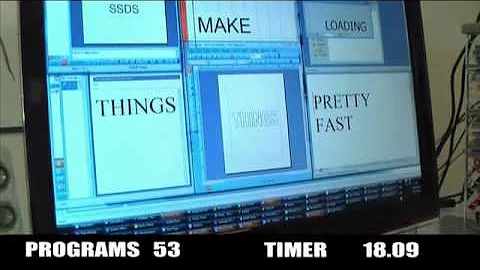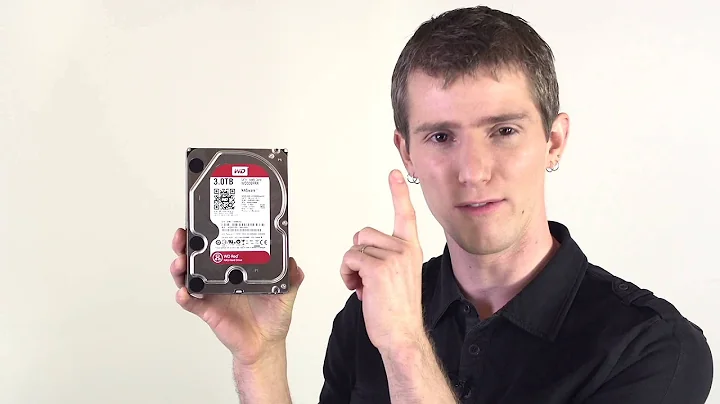SSD + Hard Disk RAID-0 Efficiency?
Solution 1
Depends on a number of things, I would think. Striping two drives into one does increase the odds of losing data in a failure, so a backup is a must.
It also depends on what data is written where and in what order, although it's probably fast because the OS and early-install stuff is striped across the SSD drive. Eventually larger data files will just hit the slower drive and the benefit will drop off a bit.
If you're just using it as a general-purpose home computer and aren't looking to increase reliability, then yeah, you'd get a hybrid performance machine that will not be as good as pure SSD in performance but better than two 7200 RPM disks.
Have I done it before? No. I wouldn't want to decrease reliability of my system and increase odds of data loss for the sake of faster drive performance. Soon enough using the system will turn into a baseline of performance and I'll forget that it's "faster", and by the time I notice newer drives and bus technologies will still leave me drumming my fingers wishing my word processor launched a fraction of a second quicker.
Solution 2
I've been thinking about this for the last 10-15 minutes and apart from getting a Jonas Brothers tattoo I haven't been able to come up with a stupider idea.
My recommendation: change it today.
Solution 3
From my experience, I would actually suggest an approach that may work out most ideally, but it will take some fine tuning. Place the O.S. on the SSD, on the "C:" partition. Also ensure that your virtual memory is set to this drive & partition as well. Leaving a descent chunk for Windows' updates & fragmentation breathing room, use the rest of the SSD to make a second partition. Use this second partition to stripe with your HDD for all of your program files. This way, you can gain the maximum booting speed benefit of going strictly with SSD, maximum virtual memory read & write speed by going strictly with SSD.....and the half-way between benefit for all of your games & normal programs.
Solution 4
I've been contemplating attempting this as I have a 64GB SDD to play with for a short while (maybe longer, we'll see...). However, I'd expect that the OPs machine has a Z68 chipset and is using Intel's Smart Response Technology so that the SDD is used as an active, adaptive, cache.
One issue, however, that using a standard MLC SSD may have in an SRT config is that I don't believe TRIM can function on the cache SSD, so write speeds will eventually become abysmal and you may need to wipe the drive PROPERLY (no quick format, here...) to regain those write speeds...
Intel SSDs may show less of a problem, however, as they do maintenance across writes, however their performance isn't as drastic when compared to a nice Crucial M4 - but the M4/C300 relies on TRIM support to prevent slow-downs...
That said, I'd think that RAID 0 with an SSD and a HDD would result in an averaging of performance between the two drives.
When a read in RAID 0 occurs, the controller organizes the reads in stripes across the drives, so the first 64KB comes from the SSD, and the second comes from the HDD. If you are making a small read, you will be playing Russian roulette as to which drive will contain the data (odd stripes on SSD, even on HDD, or the modulus of the drive count, more accurately[without going overboard....]). A large read will see an average of the seek times and read performances.
It would be somewhat schizophrenic... and the SSD would spend 50% of its life or more waiting on the HDD to do something...
My solution would be to use the SSD as boot and core applications, and then to install large applications to a standard hard drive (this coming from a guy who is running a 2x2 RAID 10 boot volume, 3x0 RAID 0 for additional, fast, storage, and a >2TB server for backups ;-) ). If you have an odd application that requires itself to be installed on "C" then you can merely create a "junction" ( mklink /j [link] [path] ) so that the data is redirected to the storage location of your choice, and the application is none the wise ;-) Also a great way to move existing installations in the future without messing with re-installs...
--The loon
Solution 5
A 64GB drive plus a 300GB drive in RAID0 does not make sense. And combining such dramatically different types of disks in a RAID array doesn't fit logically either.
However, an increasingly common arrangement is to attach some flash memory to a normal disk and call it a hybrid drive. These drives offer specific significant benefits, particularly when used with mobile devices.
It's possible that your two drives could have been combined to give the same performance characteristics of a hybrid drive. This wouldn't be automatic, of course; there would have to be some driver deciding which of the two drives to store data on in order to give the best performance boost. Newer hybrid drives do this within the disk itself, though it's conceivable that it could be done purely in software instead, even with two separate disk channels.
From the user's perspective, these drives would be combined to form one larger disk. But it wouldn't be RAID.
Related videos on Youtube
Comments
-
Tyson Navarre almost 2 years
Recently I bought a PC that came with a 64GB SSD along with a 300GB 7200 RPM hard disk drive. I thought that they would use the 64GB SSD to install the OS with the HDD acting as a data drive. I was shocked to see that they used a striped raid to combine both drives into one surprisingly fast logical drive.
I never thought of creating a RAID combing the two types of drives. Has anyone else tried this? To me this seems like a great way to get blazing fast boot and general seek times while taking advantage of the cheaper HDDs for extra storage.
-
Matt Simmons almost 14 yearsDon't you lose 235GB on the 300GB disk, as well?
-
johnh almost 14 yearswhat vendor did this? (as i would like to stay away from this vendor in the future)
-
user1364702 almost 14 years@Matt: what do you mean lose? If you're striping them together in to one volume, you combine the two physical disks into one big disk. If it were mirrored, you'd have one volume 64 gig and one volume 235, but mirroring isn't striped. Sounds like they just made one big volume with a lower reliability, RAID 0.
-
jscott almost 14 years@Bart: I don't do RAID0, but isn't it 2x$minDiskSize? en.wikipedia.org/wiki/Standard_RAID_levels#RAID_0
-
user1364702 almost 14 yearsIf it's actually RAID 0 then yes. It may actually be JBOD-just a bunch of disks.
-
user1364702 almost 14 yearsAs vendors try pushing whiz-bang features and computers grow more powerful, there's an increasing number of implementation hybridizations out there. I'd suspect that he's actually using JBOD of some kind which would also explain the current performance gain. Still no redundancy.
-
Tyson Navarre over 13 years@johnh: It was an HP slim desktop machine.
-
-
 Philip almost 14 years+1 "Soon enough using the system will turn into a baseline of performance"
Philip almost 14 years+1 "Soon enough using the system will turn into a baseline of performance" -
 Philip almost 14 years+1 "Jonas Brothers tattoo"
Philip almost 14 years+1 "Jonas Brothers tattoo" -
Gabriele Petrioli almost 14 years... +1 for making me cackle...
-
 Ben Voigt over 12 yearsI'd expect that the OP's machine doesn't have Z68, look at the date. But yes, the Intel cache would be the right way to do this.
Ben Voigt over 12 yearsI'd expect that the OP's machine doesn't have Z68, look at the date. But yes, the Intel cache would be the right way to do this.




